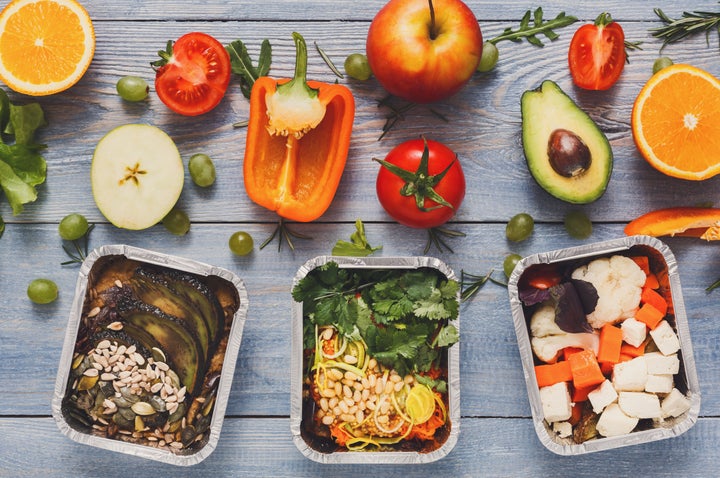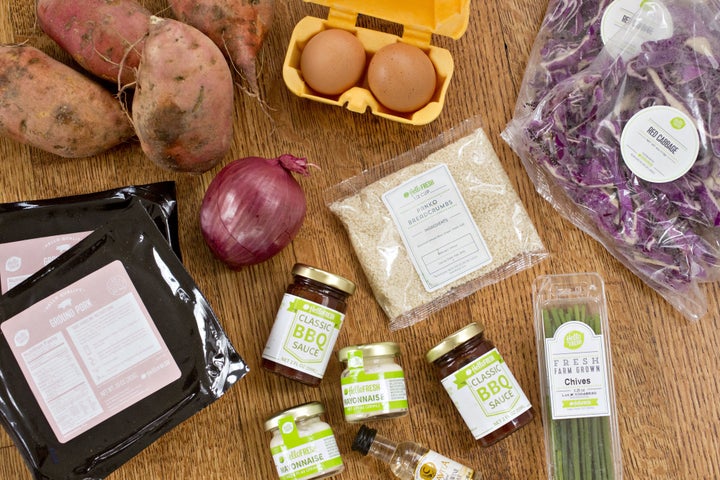
Something has to give.
Our modern working lives are busier and busier, but we still crave time for family and recreation. It’s no real surprise that we’re beginning to delegate the chores that take up our precious Saturday mornings ― sending out the dry cleaning or hiring a service to tidy up our homes ― and we can now outsource grocery shopping and meal preparation, as well.
Companies like Blue Apron, Home Chef, Freshly, Sun Basket, Green Chef and Hello Fresh have filled the market with prepared meal kits that include everything needed to create a quick and tasty meal, along with a recipe card, delivered straight to our doors. But are they really worth our extra money? What about the environmental impact of the extra packaging and shipping?
Here’s a breakdown of the pros and cons of meal preparation and delivery services.
The Good Stuff
These kits are a lifesaver for many busy families or for those who are, shall we say, culinarily challenged, but their biggest selling point is that they give you back that most precious of commodities, time.
They allow you to maximize your downtime.
Most of us come home to a list of chores to get through before we can actually spend time with our family and friends or take up a hobby or sport. For women, especially, the demands can be enormous. A study from the U.K. found that women spend five hours a week more than men on unpaid labor including housework, cooking and childcare.
Meal delivery services help to level the playing field a little in relationships by easing at least some of the demands of running a home. The meals come ready to cook, saving time at the recipe-planning stage, at the store and on the chopping and preparing of ingredients. Most of the meal kits are ready in 30 minutes or less, giving you hours back during the week to spend on more enjoyable tasks.
The meals are more nutritious than takeout.
When we’re strapped for time and short on ideas, it’s easy to fall back on the stack of menus from our local fast food restaurants. The problem is that these meals are often less than healthy.
Kristin Koskinen, a registered dietitian and nutritionist with a private practice in Washington state, says that meal kits can be a bridge to a better diet. “They can help transition people from eating most meals out to eating more meals at home by taking the decision making out of what’s for dinner and eliminating grocery shopping. Eating at home typically translates to better diets, higher nutrient intake, and weight loss for those looking to shed a few pounds,” she told HuffPost.
Kits can help support less experienced cooks.
Cooking is a skill ― and like any skill, it requires patience and practice to master. Meal deliveries come with recipe cards that guide novice chefs through the cooking process from start to finish. They often have photos showing exactly how the food should look and step-by-step instructions to help less-experienced cooks develop their kitchen skills.

The Bad Stuff
Even though these services work for many people, there are some downsides.
There’s a ton of excess packaging.
To keep the food fresh and appealing, each individual element needs to be vacuum-sealed. So every individual element of the meal kit ― chopped onions, herbs, sauces, etc. ― is vacuum-sealed and secured in plastic and cardboard before being placed inside more packaging.
The entire delivery has to be kept safe and cool with ice packs or insulating material to prevent temperature fluctuations that could cause spoiling or even food poisoning. Most meal delivery companies provide information about how you can recycle the packaging, but it produces a lot more waste than if you just go shopping yourself with reusable bags.
However, fans of meal kits argue that they are good for the environment because they reduce food waste ― every kit comes with only the necessary amount of ingredients for each recipe. It’s been reported that 21 percent of food waste in the U.S. results from consumers who buy too much. Pre-measured ingredients cut down on over-purchasing that often results in wilted vegetables in the bottom of the fridge, contributing to America’s 150,000 tons of discarded household food per day.
Kits stifle our culinary creativity.
Some critics claim that meal delivery services that tell you what to cook in exact steps and provide all the ingredients are not allowing a natural curiosity to develop through trial and error. But is it really any different than following any other recipe?
Christen Cupples Cooper, assistant professor and founding director of the Nutrition and Dietetics Program at the College of Health Professions at Pace University, wants to see more Americans cooking at home and thinks these services could help to achieve that goal. “For some, especially those with curiosity and the will to get back to home cooking but lacking the time, meal delivery services can be really useful. If they can help people to get back to preparing and eating healthful, sit-down meals with their family, then I applaud them,” she said.
Blue Apron user Mike Gnitecki actually finds that the recipes make him a more creative cook by giving him ideas to try that he wouldn’t otherwise have had exposure to.
“Yesterday, with the help of the recipe, I made seared steak over goat cheese polenta. I would never have thought to have made that otherwise,” he told HuffPost.
The price of kits can get expensive.
Meal kits are very convenient, but they don’t come cheap. Although most of the larger companies offer special low prices to new customers and lots of users bounce around from company to company until the discounts run out, the regular prices can be prohibitive for many people.
Meal kits can be cheaper than eating at a restaurant, but they are still more expensive than buying the ingredients and cooking yourself. And these calculations don’t account for the fact that grocery shopping can mean you’re left with a lot of extra food that is either wasted or has to be repurposed into another recipe, requiring more time and effort for the cook.
Gnitecki finds the cost of meal kits a bit too high to use them regularly, but sees them as an investment in his cooking skills. “It’s not something I can afford to do a lot, but when I do buy a box, I consider the cost a sort of tuition for learning,” he said.
Though critics are concerned that meal delivery services are wasteful in terms of packaging or simply a fad, they seem to have found a market. Statista says that meal kits generated $1 billion worldwide revenue in 2015, expected to reach $10 billion by 2020. However, the recent shuttering of Chef’d could point to an oversaturation of meal prep services, especially as big players like Walmart and Amazon enter the market. Although meal kits are not perfect, they can free up your time and give you a few new recipe ideas.